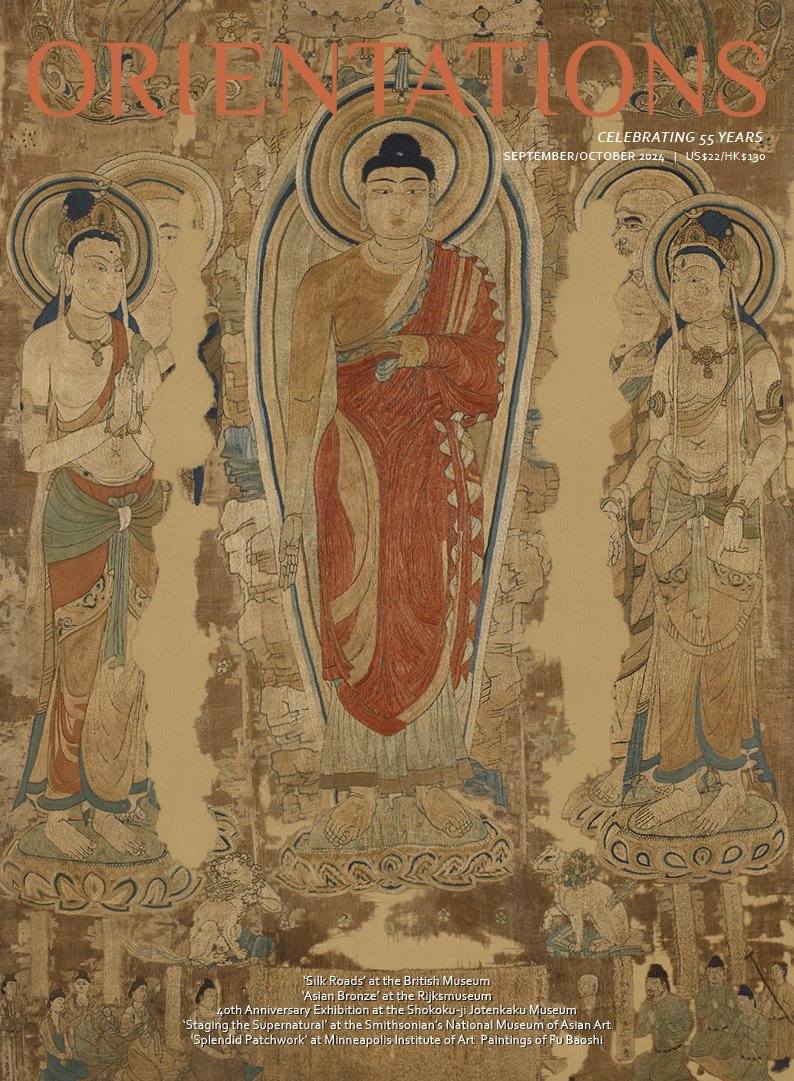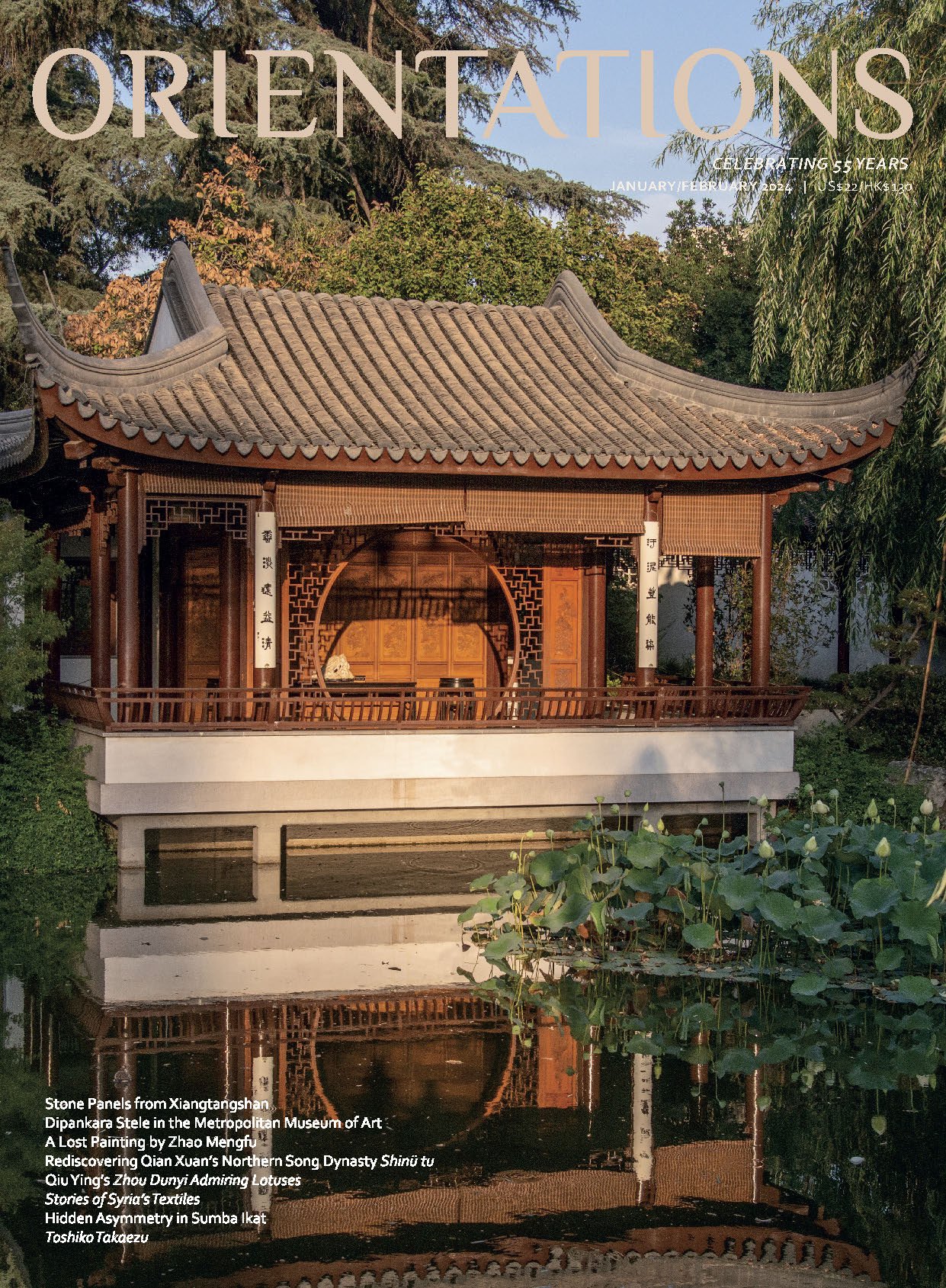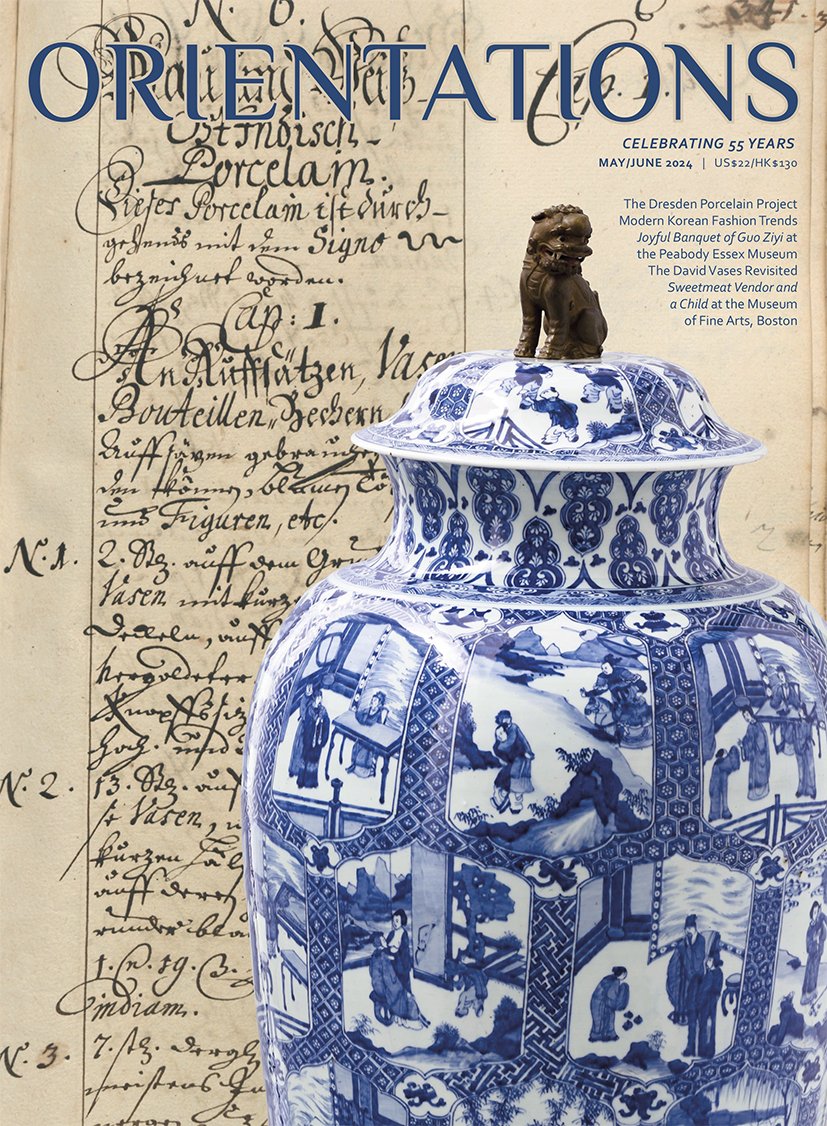SEP/OCT 2024
The Silk Road has captured the imagination of many, not only as a historic trade route that facilitated the exchange of goods, culture, religion, ideas, and people, but also as a symbol, conjuring up romantic images of traders crossing the desert and a sense of adventure. This fall, the British Museum will open ‘Silk Roads’, an ambitious exhibition that offers a fresh perspective by focusing on the period between the years 500 to 1000. It leverages the British Museum’s own vast collection and also includes significant loans from 29 partners to highlight the historical importance of Central Asia within this network.
The exhibition is co-curated by experts from across the British Museum—Sue Brunning (early medieval Europe), Yu-ping Luk (Chinese and Central Asian art), and Elisabeth O’Connell (Byzantine world)—and we are pleased to work with Luk to bring readers several articles, including one on vessels excavated from 4th–6th century tombs in Gyeongju, the capital of the ancient Korean kingdom of Silla, and another on the silk weavings of the Sogdian nobility as revealed in 7th century wall paintings from the ‘Hall of Ambassadors’ in Samarkand.
Also opening this fall is the British Library’s new exhibition ‘A Silk Road Oasis: Life in Ancient Dunhuang’.
At the Rijksmuseum, ‘Asian Bronze: 4000 Years of Beauty’ traces the development of bronze casting in Asia from its prehistoric and protohistoric origins to modern and contemporary creations through a selection of 75 bronze pieces from across Asia. The categorization of these masterworks according to their unique production methods underscores the localized expertise and exceptional mastery with which these techniques developed in specific areas.
We look at the treasures accumulated and preserved over generations by important temples that will be exhibited in ‘The Legacy of Zen Temples: Shōkoku-ji, Kinkaku-ji and Ginkaku-ji’, which opens at the Aichi Prefectural Museum of Art this October before travelling to the University Art Museum, Tokyo University of the Arts, next March.
Currently on view at the Smithsonian’s National Museum of Asian Art until October, ‘Staging the Supernatural: Ghosts and the Theater in Japanese Prints’ highlights supernatural representations in Japanese prints. A fitting article for this issue, which comes out during the Ghost Festival month of the lunar calendar, the exhibition theme was first formulated by the two curators as graduate students and later realized through key acquisitions, including the Pearl Moskowitz Collection.
The Minneapolis Institute of Art continues to surprise with its extensive collection, including nearly a thousand Qing dynasty silk textiles that form one of the largest holdings in the West. The exhibition ‘Splendid Patchwork: Buddhist Monastic Robes’ focuses on just one area, Daoist and Buddhist ecclesiastical garments. The robes, which retain their traditional form and are worn either by high monks or in performances, are striking examples of artistry and imperial influence, fusing religious and imperial authority.
FEATURES
Yu-ping Luk. Silk Roads at the British Museum
Yoon Sangdeok. Glass Vessels from 4th to 6th Century Silla Tombs
Alessandro Armigliato, Yu-ping Luk, Laura Perucchetti, Ruiliang Liu, and Janet Lang. Exploring the Making of Tang Silverware from the British Museum Collection
Zhao Feng, Yu-ping Luk, Diego Tamburini, Wang Shujuan, Liu Jian, and Long Bo. Reconstructing Dunhuang Textiles and Their Methods of Production: A China-UK Collaboration
Zumrad Ilyasova. From Cocoons to Kaftans: Splendid Silks at the Sogdian Court in Samarkand
Sara Creange, Anna A. Ślączka, William Southworth, and Ching-Ling Wang. Asian Bronze: 4000 Years of Beauty
Shokoku-ji Jotenkaku Museum 40th Anniversary Exhibition Legacy of Zen Temples: Shokoku-ji, Kinkaku-ji and Ginkaku-ji, Kyoto
Kit Brooks and Frank Feltens. Staging the Supernatural: Ghosts and the Theatre in Japanese Prints
Liu Yang. Splendid Patchwork: Buddhist Monastic Robes from Minneapolis Institute of Art
Lisa Claypool. An Ink Painter’s Eyes Wide Shut
REVIEWS
Jyotindra Jain. Tree & Serpent: Early Buddhist Art in India
Olivia Wang. Abstract Evolutions: Sixty Years of Paintings by Fong Chung-Ray
Julie M. Segraves. India Art Fair 2024
The Silk Road has captured the imagination of many, not only as a historic trade route that facilitated the exchange of goods, culture, religion, ideas, and people, but also as a symbol, conjuring up romantic images of traders crossing the desert and a sense of adventure. This fall, the British Museum will open ‘Silk Roads’, an ambitious exhibition that offers a fresh perspective by focusing on the period between the years 500 to 1000. It leverages the British Museum’s own vast collection and also includes significant loans from 29 partners to highlight the historical importance of Central Asia within this network.
The exhibition is co-curated by experts from across the British Museum—Sue Brunning (early medieval Europe), Yu-ping Luk (Chinese and Central Asian art), and Elisabeth O’Connell (Byzantine world)—and we are pleased to work with Luk to bring readers several articles, including one on vessels excavated from 4th–6th century tombs in Gyeongju, the capital of the ancient Korean kingdom of Silla, and another on the silk weavings of the Sogdian nobility as revealed in 7th century wall paintings from the ‘Hall of Ambassadors’ in Samarkand.
Also opening this fall is the British Library’s new exhibition ‘A Silk Road Oasis: Life in Ancient Dunhuang’.
At the Rijksmuseum, ‘Asian Bronze: 4000 Years of Beauty’ traces the development of bronze casting in Asia from its prehistoric and protohistoric origins to modern and contemporary creations through a selection of 75 bronze pieces from across Asia. The categorization of these masterworks according to their unique production methods underscores the localized expertise and exceptional mastery with which these techniques developed in specific areas.
We look at the treasures accumulated and preserved over generations by important temples that will be exhibited in ‘The Legacy of Zen Temples: Shōkoku-ji, Kinkaku-ji and Ginkaku-ji’, which opens at the Aichi Prefectural Museum of Art this October before travelling to the University Art Museum, Tokyo University of the Arts, next March.
Currently on view at the Smithsonian’s National Museum of Asian Art until October, ‘Staging the Supernatural: Ghosts and the Theater in Japanese Prints’ highlights supernatural representations in Japanese prints. A fitting article for this issue, which comes out during the Ghost Festival month of the lunar calendar, the exhibition theme was first formulated by the two curators as graduate students and later realized through key acquisitions, including the Pearl Moskowitz Collection.
The Minneapolis Institute of Art continues to surprise with its extensive collection, including nearly a thousand Qing dynasty silk textiles that form one of the largest holdings in the West. The exhibition ‘Splendid Patchwork: Buddhist Monastic Robes’ focuses on just one area, Daoist and Buddhist ecclesiastical garments. The robes, which retain their traditional form and are worn either by high monks or in performances, are striking examples of artistry and imperial influence, fusing religious and imperial authority.
FEATURES
Yu-ping Luk. Silk Roads at the British Museum
Yoon Sangdeok. Glass Vessels from 4th to 6th Century Silla Tombs
Alessandro Armigliato, Yu-ping Luk, Laura Perucchetti, Ruiliang Liu, and Janet Lang. Exploring the Making of Tang Silverware from the British Museum Collection
Zhao Feng, Yu-ping Luk, Diego Tamburini, Wang Shujuan, Liu Jian, and Long Bo. Reconstructing Dunhuang Textiles and Their Methods of Production: A China-UK Collaboration
Zumrad Ilyasova. From Cocoons to Kaftans: Splendid Silks at the Sogdian Court in Samarkand
Sara Creange, Anna A. Ślączka, William Southworth, and Ching-Ling Wang. Asian Bronze: 4000 Years of Beauty
Shokoku-ji Jotenkaku Museum 40th Anniversary Exhibition Legacy of Zen Temples: Shokoku-ji, Kinkaku-ji and Ginkaku-ji, Kyoto
Kit Brooks and Frank Feltens. Staging the Supernatural: Ghosts and the Theatre in Japanese Prints
Liu Yang. Splendid Patchwork: Buddhist Monastic Robes from Minneapolis Institute of Art
Lisa Claypool. An Ink Painter’s Eyes Wide Shut
REVIEWS
Jyotindra Jain. Tree & Serpent: Early Buddhist Art in India
Olivia Wang. Abstract Evolutions: Sixty Years of Paintings by Fong Chung-Ray
Julie M. Segraves. India Art Fair 2024
The Silk Road has captured the imagination of many, not only as a historic trade route that facilitated the exchange of goods, culture, religion, ideas, and people, but also as a symbol, conjuring up romantic images of traders crossing the desert and a sense of adventure. This fall, the British Museum will open ‘Silk Roads’, an ambitious exhibition that offers a fresh perspective by focusing on the period between the years 500 to 1000. It leverages the British Museum’s own vast collection and also includes significant loans from 29 partners to highlight the historical importance of Central Asia within this network.
The exhibition is co-curated by experts from across the British Museum—Sue Brunning (early medieval Europe), Yu-ping Luk (Chinese and Central Asian art), and Elisabeth O’Connell (Byzantine world)—and we are pleased to work with Luk to bring readers several articles, including one on vessels excavated from 4th–6th century tombs in Gyeongju, the capital of the ancient Korean kingdom of Silla, and another on the silk weavings of the Sogdian nobility as revealed in 7th century wall paintings from the ‘Hall of Ambassadors’ in Samarkand.
Also opening this fall is the British Library’s new exhibition ‘A Silk Road Oasis: Life in Ancient Dunhuang’.
At the Rijksmuseum, ‘Asian Bronze: 4000 Years of Beauty’ traces the development of bronze casting in Asia from its prehistoric and protohistoric origins to modern and contemporary creations through a selection of 75 bronze pieces from across Asia. The categorization of these masterworks according to their unique production methods underscores the localized expertise and exceptional mastery with which these techniques developed in specific areas.
We look at the treasures accumulated and preserved over generations by important temples that will be exhibited in ‘The Legacy of Zen Temples: Shōkoku-ji, Kinkaku-ji and Ginkaku-ji’, which opens at the Aichi Prefectural Museum of Art this October before travelling to the University Art Museum, Tokyo University of the Arts, next March.
Currently on view at the Smithsonian’s National Museum of Asian Art until October, ‘Staging the Supernatural: Ghosts and the Theater in Japanese Prints’ highlights supernatural representations in Japanese prints. A fitting article for this issue, which comes out during the Ghost Festival month of the lunar calendar, the exhibition theme was first formulated by the two curators as graduate students and later realized through key acquisitions, including the Pearl Moskowitz Collection.
The Minneapolis Institute of Art continues to surprise with its extensive collection, including nearly a thousand Qing dynasty silk textiles that form one of the largest holdings in the West. The exhibition ‘Splendid Patchwork: Buddhist Monastic Robes’ focuses on just one area, Daoist and Buddhist ecclesiastical garments. The robes, which retain their traditional form and are worn either by high monks or in performances, are striking examples of artistry and imperial influence, fusing religious and imperial authority.
FEATURES
Yu-ping Luk. Silk Roads at the British Museum
Yoon Sangdeok. Glass Vessels from 4th to 6th Century Silla Tombs
Alessandro Armigliato, Yu-ping Luk, Laura Perucchetti, Ruiliang Liu, and Janet Lang. Exploring the Making of Tang Silverware from the British Museum Collection
Zhao Feng, Yu-ping Luk, Diego Tamburini, Wang Shujuan, Liu Jian, and Long Bo. Reconstructing Dunhuang Textiles and Their Methods of Production: A China-UK Collaboration
Zumrad Ilyasova. From Cocoons to Kaftans: Splendid Silks at the Sogdian Court in Samarkand
Sara Creange, Anna A. Ślączka, William Southworth, and Ching-Ling Wang. Asian Bronze: 4000 Years of Beauty
Shokoku-ji Jotenkaku Museum 40th Anniversary Exhibition Legacy of Zen Temples: Shokoku-ji, Kinkaku-ji and Ginkaku-ji, Kyoto
Kit Brooks and Frank Feltens. Staging the Supernatural: Ghosts and the Theatre in Japanese Prints
Liu Yang. Splendid Patchwork: Buddhist Monastic Robes from Minneapolis Institute of Art
Lisa Claypool. An Ink Painter’s Eyes Wide Shut
REVIEWS
Jyotindra Jain. Tree & Serpent: Early Buddhist Art in India
Olivia Wang. Abstract Evolutions: Sixty Years of Paintings by Fong Chung-Ray
Julie M. Segraves. India Art Fair 2024






